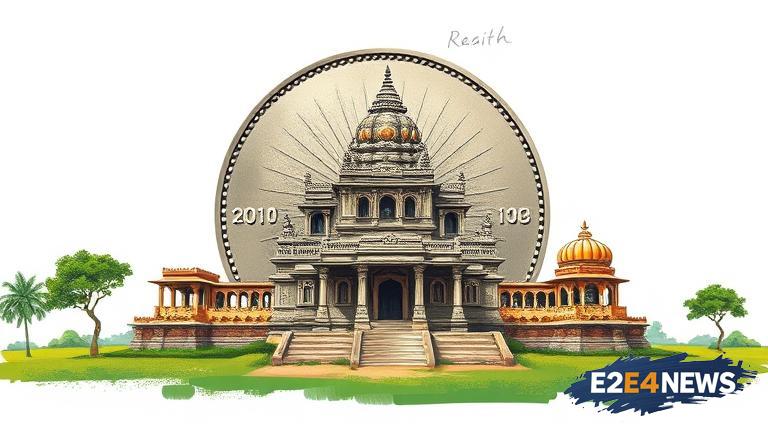The Indian government has recently introduced a new Rs 1,000 coin, featuring the iconic Gangaikonda Cholapuram temple. This ancient temple, located in the state of Tamil Nadu, is a testament to the rich cultural heritage of India. The temple was built during the reign of Rajendra I, a prominent king of the Chola dynasty, in the 11th century. Gangaikonda Cholapuram is considered one of the most significant architectural achievements of the Chola period, showcasing the advanced engineering and artistic skills of the time. The temple’s design is a blend of traditional Dravidian architecture and innovative techniques, making it a unique and fascinating structure. The temple complex is dedicated to Lord Shiva and features an impressive 55-meter-tall vimana, or tower, which is adorned with intricate carvings and sculptures. The temple’s walls are covered in elaborate frescoes, depicting scenes from Hindu mythology and everyday life. The Gangaikonda Cholapuram temple is not only an important cultural landmark but also a significant historical site, providing valuable insights into the lives of the people who built it. The temple’s construction is believed to have been inspired by the king’s military campaigns and his desire to create a lasting legacy. The Chola dynasty, which ruled much of southern India from the 3rd to the 13th centuries, was known for its military prowess, administrative skills, and cultural achievements. The dynasty’s kings were patrons of the arts, and their courts attracted scholars, poets, and artists from all over India. The Gangaikonda Cholapuram temple is a reflection of the Chola dynasty’s rich cultural heritage and its significant contributions to Indian architecture, art, and literature. The temple has been recognized as a UNESCO World Heritage Site, acknowledging its importance as a cultural and historical landmark. The Indian government’s decision to feature the Gangaikonda Cholapuram temple on the new Rs 1,000 coin is a testament to the country’s pride in its rich cultural heritage. The coin is expected to be a popular collector’s item, not only among numismatists but also among history buffs and cultural enthusiasts. The Gangaikonda Cholapuram temple is a must-visit destination for anyone interested in exploring India’s rich cultural heritage. The temple’s stunning architecture, intricate carvings, and beautiful frescoes make it a truly unforgettable experience. Visitors to the temple can explore the complex, which includes several smaller shrines and a large temple tank. The temple is also an important center of learning, with many scholars and researchers studying its history, architecture, and cultural significance. The Gangaikonda Cholapuram temple is a powerful symbol of India’s rich cultural diversity and its ability to inspire and awe people from all over the world. The temple’s significance extends beyond its cultural and historical importance, as it also represents the country’s commitment to preserving its heritage and promoting cultural understanding. The Indian government’s efforts to promote the Gangaikonda Cholapuram temple and other cultural landmarks are an important step towards preserving the country’s rich cultural heritage for future generations. In conclusion, the Gangaikonda Cholapuram temple is an extraordinary cultural and historical landmark that deserves to be recognized and celebrated. The Indian government’s decision to feature the temple on the new Rs 1,000 coin is a fitting tribute to this incredible monument and a testament to the country’s pride in its rich cultural heritage.





